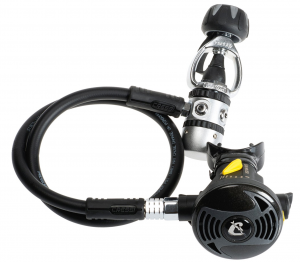 It’s pretty amazing to think we can actually be breathing and spend lots of time underwater all because of a regulator.
It’s pretty amazing to think we can actually be breathing and spend lots of time underwater all because of a regulator.
If you’re thinking of learning to scuba dive, you might be wondering what a scuba dive regulator is? I’m here to tell you all about it!
The regulator when connected to the air tank will give you the right amount of compressed air at low pressure when you actually need it. It’s the most important piece of your dive gear… your lifeline between you and your air source, your scuba tank!
When you look at a regulator, you’ll see what looks like a hub, similar to a network hub that has multiple connection points. You might even think of it as looking like an octopus!!
I’ll explain to you in simple language for you to understand the role of an regulator. I have images for you. I’ll tell you how it works, what to look for when purchasing your regulator for the certified diver, and why it’s so important getting the right regulator for your needs.
Short Note on Scuba Tanks
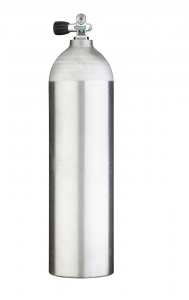 Because i’m going to be mentioning scuba tanks, let me first tell you briefly what a scuba tank is. A scuba tank is made from either aluminum or steel. If you’re a recreational diver, your tank is filled with compressed purified air which is about 20.9% oxygen.
Because i’m going to be mentioning scuba tanks, let me first tell you briefly what a scuba tank is. A scuba tank is made from either aluminum or steel. If you’re a recreational diver, your tank is filled with compressed purified air which is about 20.9% oxygen.
There are 2 types of valves that can be on a tank….
1) Yoke Valve
2) DIN Valve.
Keep these 2 things in mind as we move along…
5 Main Components of a Dive Regulator
The regulator has 5 major features vital for it to perform properly and safely for you.
1) First Stage
2) Primary Second Stage
3) Alternate Air Source
4) Low Pressure Inflator
5) SPG (Submersible Pressure Gauge)
The First Stage
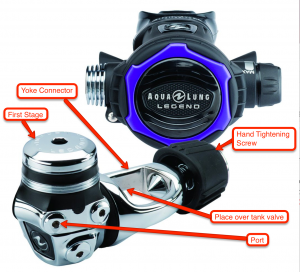 The First Stage of the regulator connects to the scuba tank valve. It controls the high pressure of compressed air that’s in the tank by reducing it to an intermediate pressure and directing it to its other pressure hoses.
The First Stage of the regulator connects to the scuba tank valve. It controls the high pressure of compressed air that’s in the tank by reducing it to an intermediate pressure and directing it to its other pressure hoses.
There are 2 types of connectors that you can connect your regulator’s first stage to your scuba tank. When you go to your dive shop or go online you’ll see there are regulators with a yoke valve fitting and regulators with a DIN valve fitting.
Wondering how to tell what type of regulator and scuba tank you have?
1) Regulators With Yoke Valve Connector
 The Yoke Valve connector will have the appearance of an A-Clamp frame.
The Yoke Valve connector will have the appearance of an A-Clamp frame.
The best way to identify a matching scuba tank for this type of regulator is you should be able to visibly see an o-ring that’s placed in the scuba tank’s valve groove.
How to connect this regulator to the scuba tank:
You first remove the black rubber dust cap, and place the regulator’s first stage with the connected yoke valve over the tank valve and simply tighten the screw that’s attached to the black knob by hand. This clamps the first stage to the tank.
2) Regulators With Din Valve Connector
These regulators are popular among technical divers who do deep diving, cave diving, and cold water diving because of a better connection between the regulator and the tank.
While these are more widely used in areas outside of the US like Europe, they are also becoming more popular with recreational divers in the US and Canada as they are much more versatile to types of diving.
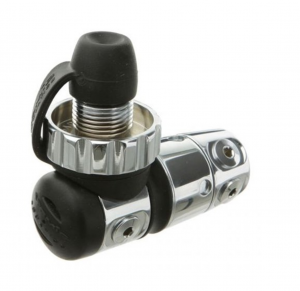 Best way to identify this type of regulator:
Best way to identify this type of regulator:
The DIN connector comes with an integrated o-ring and is well protected. It does not look like an A-Frame.
Best way to identify a matching scuba tank for this regulator is the tank valve will have a large threaded opening and will not have an o-ring.
How to connect this regulator to the scuba tank:
Place the regulator’s first stage DIN connector into the opening of the tank valve and screw it in place by rotating the black knob.
Note:
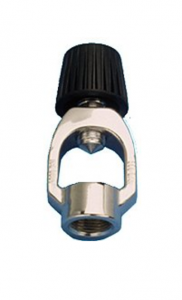 a) If your tank has a yoke valve and you have a DIN connector in your regulator’s first stage, there’s no need to worry….!
a) If your tank has a yoke valve and you have a DIN connector in your regulator’s first stage, there’s no need to worry….!
You can easily purchase an a DIN to Yoke Converter on Amazon that will allow you to simply screw into your regulator’s first stage. This gives you an A-frame that will go over the tank valve with the visible o-ring. Take this on all your dive trips!
b) If your tank has a DIN valve and you have a Yoke Regulator, the dive shop should be able to switch tanks for you.
The Port
The Port which is part of the First Stage has multiple openings to house your regulator’s high pressure and low pressure hoses.
The high pressure hoses are for your pressure gauge or dive computer and the low pressure hoses are for the mouthpiece, your BCD inflator and alternate air source.
The Primary Second Stage
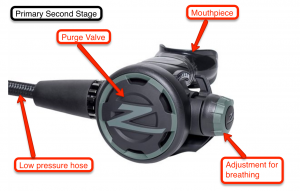 The Primary Second Stage further reduces the regulator’s First Stage intermediate pressure to a pressure that’s equal to the diver’s surrounding water pressure.
The Primary Second Stage further reduces the regulator’s First Stage intermediate pressure to a pressure that’s equal to the diver’s surrounding water pressure.
The Primary Second Stage is the mouthpiece the diver safely breathes from. It’s attached to the first stage port via a low pressure hose. It also comes with a purge valve and an exhaust valve.
It’s commonly referred to as a Demand stage because it’s dependent on when the diver underwater, needs to inhale at a pressure that’s setup to breathe normally.
1) Purge Valve Button
If for some reason underwater, you have to release your mouthpiece from your mouth and put it back into your mouth. You’ll soon realize you have water in your mouthpiece. At this point, you will need to push the purge valve button to flood the second stage with air which then forces the water out from your mouthpiece. The purge valve button is located at the back of the mouthpiece.
2) Adjustment Knob for Breathing
As you descend underwater, you might experience some resistance to your breathing. You can adjust this resistance by turning the adjustment knob located on the other side of the mouthpiece opposite the low pressure hose attachment.
3) Exhaust Valve
The exhaust valve is located just below the mouthpiece and it doesn’t allow water in because it’s one way.
Have you noticed a diver underwater exhale bubbles? This is the diver’s exhaled air that escapes into the water thru the exhaust valve.
Alternate Air Source
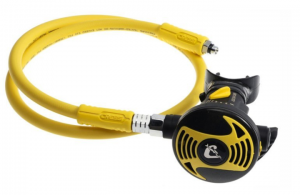 This is usually identified with a bright neon yellow mouthpiece and is attached to a yellow coloured low pressure hose connected to the first stage. It’s intended for a diver who’s run out of air to share air with you or if you need it because something happened to your primary second stage.
This is usually identified with a bright neon yellow mouthpiece and is attached to a yellow coloured low pressure hose connected to the first stage. It’s intended for a diver who’s run out of air to share air with you or if you need it because something happened to your primary second stage.
Some BCDs have a built-in alternate air source.
Low Pressure Inflator
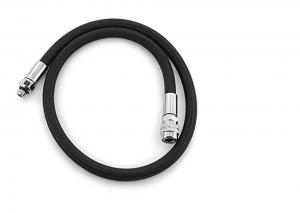 This is where you connect to your BCD (Buoyancy Control Device). The low pressure inflator, which has an attachment opening and a sleeve is attached to the first stage via a low pressure hose and carries intermediate pressure. When connected, to put air into your BCD, simply push the inflator button that’s located on your BCD.
This is where you connect to your BCD (Buoyancy Control Device). The low pressure inflator, which has an attachment opening and a sleeve is attached to the first stage via a low pressure hose and carries intermediate pressure. When connected, to put air into your BCD, simply push the inflator button that’s located on your BCD.
To connect the BCD to the regulator, look for the BCD inflator connection. Next, slide and hold back the sleeve and insert the BCD’s inflator connection into the attachment opening on the low pressure inflator hose. Release the sleeve and check to see if you have a solid connection.
Note:
Make sure you have the correct low pressure attachment opening size.
SPG (Submersible Pressure Gauge)
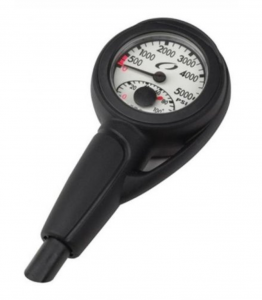 You absolutely need this because you don’t want to run out of air!
You absolutely need this because you don’t want to run out of air!
This high pressure gauge is connected by a high pressure hose to the first stage. It measures the amount of air left in your scuba tank.
Measurements can be in psi (pounds per square inch) or bars thru a mechanical gauge or thru a dive computer. The gauge is easy to read underwater and you definitely don’t want to have this dangling because not only are you not streamlined, you can damage it and hurt coral.
Quite often, you’ll see divers underwater monitoring their dives thru the use of a console. The console can house the air pressure gauge, depth gauge, compass and even a dive computer. It keeps everything neat and tidy together!
How to Choose Your Dive Regulator That’s Right For You!
If you plan on taking the Open Water Dive Course, your lessons will include all the dive gear rentals for the price. You’ll also learn everything you’ll need to know about regulators in that course.
After you get your certification, I recommend you continue to rent your dive gear just to get more familiar with all your dive gear. By then you should have an idea as to what type of dives you enjoy as well as the type of gear you want to purchase.
If you’re a new diver or a novice diver and ready to purchase your own regulator, here’s what I suggest!
1) Do lots of research. Go to dive shops and talk to dive professionals. Research online and read reviews and talk to other seasoned divers.
2) Consider the type of diving you plan to do. Will it be cold water, warm warm… perhaps both? Decide which type of valve connection you want on your First Stage. The DIN is much more diversified for all kind of diving and as I mentioned before, not only is it popular with technical divers, it’s becoming popular with recreational divers! Personally, I’d say go with the DIN!
3) Is the mouthpiece the right fit? If you’re purchasing online you need to know what size the mouthpiece is.
You don’t want water entering in your mouth. This could cause you to bite on your mouthpiece to keep water out. You also don’t want it too large or too small because it could bother your gums or get sore jaw.
4) You need to determine what you want on your regulator in addition to the mouthpiece, the alternate air source and the SPG.
5) Make sure you have enough ports on the first stage. Are they set up properly. You want high pressure hose for the SPG for example.
6) You want a regulator that can be easily serviced at a dive shop.
7) Look for a regulator that will give you the best performance in your dive environments.
8) Determine if you want your SPG to be in psi or bars. It’s best to purchase this the same time as your regulator.
9) If you have a BCD, connect your Low Pressure Inflator to it and make sure it’s the right fit.
Well folks, this is it! I hope I was able to give you useful information on a dive regulator. Which type of regulator is your preference.. the Yoke Connector or the DIN? What’s your experience with them?
If you have any questions or comment, please put them in the comment box below.
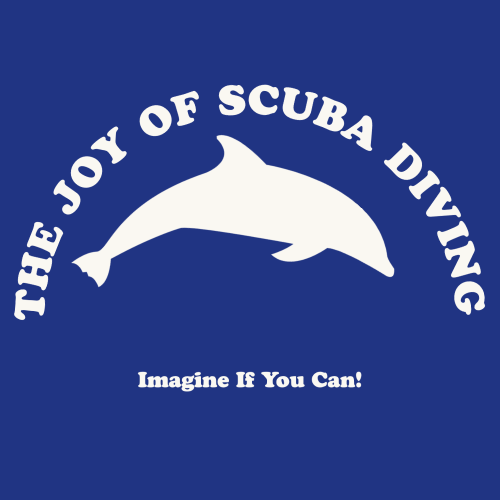
I’ve done some scuba diving in Florida in key west, I enjoyed reading this article. You have put together some valuable information on Scuba diving for beginners. If anyone looking to learn all about scuba diving should read this great article. Thanks for teaching me something about scuba diving and best wishes.
Hi Anthony,
Thank you for your comment! I’m glad you enjoyed reading this.
Always happy to help people in way I can!
Regards,
Monica
Hey Monica very informative. I have always wanted to scuba dive. Of course the fear of going that deep under water for a time kinda overwhelmed me. You have covered a lot of topics. You have practically prepared me for my first class already. My only question that I have and I apologized if i missed the information. Being a newbie diver will my nervousness cause me to use more air than if I had been diving before?
Hi,
Thank you for your comment and for the great question!
Yes, if you’re nervous… you can use more air. It’s ok to be nervous…
The best thing to do is when you’re underwater:
1) Move slowly.
2) Stay shallow, and don’t be overweighted.
3) Streamline your gear so nothing is dragging and try for neutral buoyancy.
4) Don’t flail your arms about, keep them close to your body.
5) Try to inhale deeply and exhale fully. Breathe slowly! Relax…
6) Get lots of rest… a good night sleep and don’t be arriving late to go diving.
The more dives you do, the more relaxed you become.
I hope this all helps you! Let me know if you have any more questions.
Hi Monica,
I am a lover of water sports and go all out to get information about this wonderful adventurous activity. I am a fairly new certified Open Water Diver and wondering when is a good time to purchase my own regulator and the rest of the dive gear. I have zero knowledge of which scuba diving gear is best for me. I have only used the gear from the dive shop when I did my course.
You mentioned the importance of choosing the right size mouthpiece. How can I find my right size?
Thanks
Hi Edward,
Thank you for your comment.
Here is my suggestion, don’t purchase your dive gear just yet. Becuase you are a new diver, do more dives (like 20 dives) and rent gear. This will give you more diving experience plus opportunities to see which type of gear rentals fit you comfortably. When sitting on dive boats, you can ask the other divers which make and model their gear is and how well they like it and why. This will give you a pretty good idea, which dive gear is most suitable for your needs, especially on the mouthpiece. This is what I did when I purchased my first set of gear.
You can also purchase individual mouthpiece.
I hope this helps,
Monica